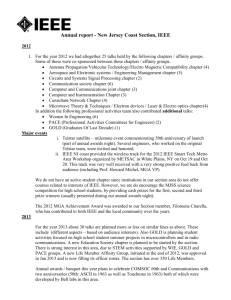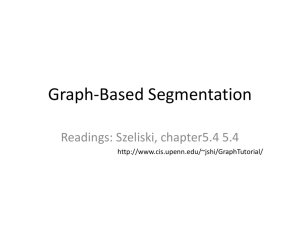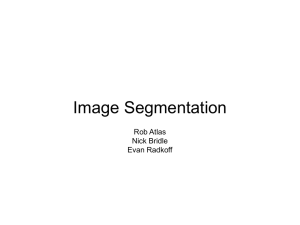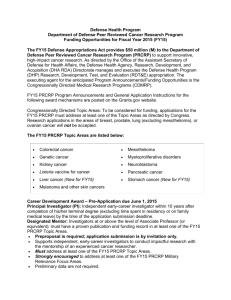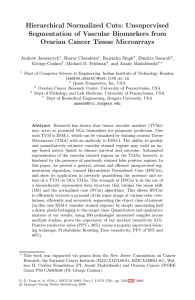- Asia Pacific - Indian Journal of Research and Practice
advertisement
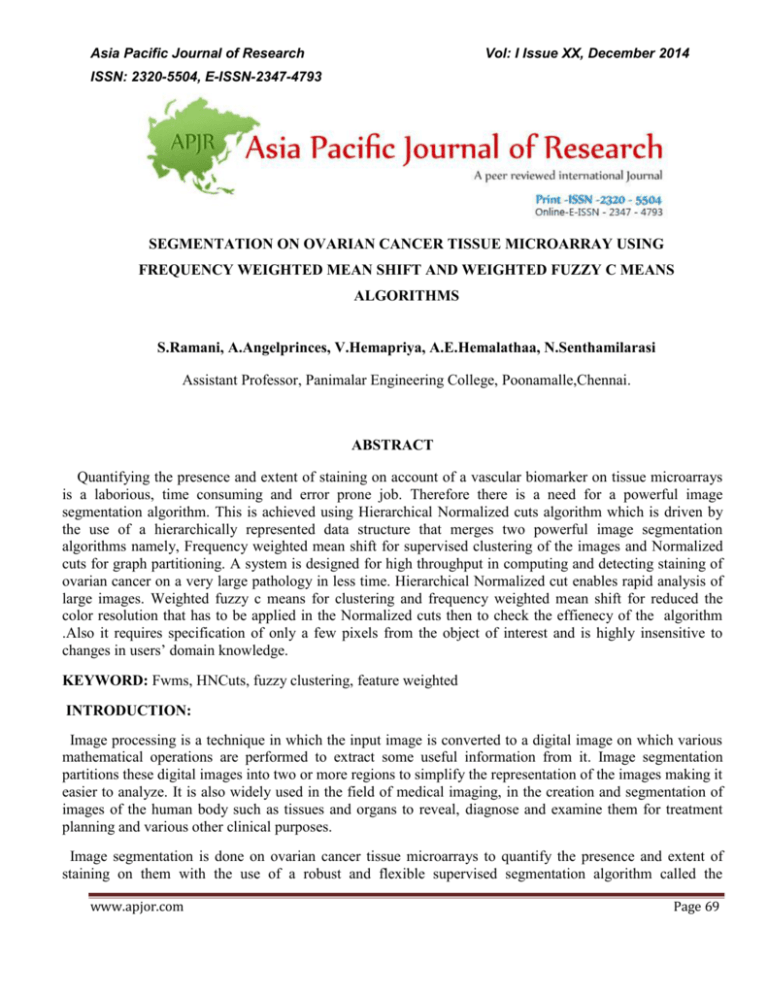
Asia Pacific Journal of Research
Vol: I Issue XX, December 2014
ISSN: 2320-5504, E-ISSN-2347-4793
SEGMENTATION ON OVARIAN CANCER TISSUE MICROARRAY USING
FREQUENCY WEIGHTED MEAN SHIFT AND WEIGHTED FUZZY C MEANS
ALGORITHMS
S.Ramani, A.Angelprinces, V.Hemapriya, A.E.Hemalathaa, N.Senthamilarasi
Assistant Professor, Panimalar Engineering College, Poonamalle,Chennai.
ABSTRACT
Quantifying the presence and extent of staining on account of a vascular biomarker on tissue microarrays
is a laborious, time consuming and error prone job. Therefore there is a need for a powerful image
segmentation algorithm. This is achieved using Hierarchical Normalized cuts algorithm which is driven by
the use of a hierarchically represented data structure that merges two powerful image segmentation
algorithms namely, Frequency weighted mean shift for supervised clustering of the images and Normalized
cuts for graph partitioning. A system is designed for high throughput in computing and detecting staining of
ovarian cancer on a very large pathology in less time. Hierarchical Normalized cut enables rapid analysis of
large images. Weighted fuzzy c means for clustering and frequency weighted mean shift for reduced the
color resolution that has to be applied in the Normalized cuts then to check the effienecy of the algorithm
.Also it requires specification of only a few pixels from the object of interest and is highly insensitive to
changes in users’ domain knowledge.
KEYWORD: Fwms, HNCuts, fuzzy clustering, feature weighted
INTRODUCTION:
Image processing is a technique in which the input image is converted to a digital image on which various
mathematical operations are performed to extract some useful information from it. Image segmentation
partitions these digital images into two or more regions to simplify the representation of the images making it
easier to analyze. It is also widely used in the field of medical imaging, in the creation and segmentation of
images of the human body such as tissues and organs to reveal, diagnose and examine them for treatment
planning and various other clinical purposes.
Image segmentation is done on ovarian cancer tissue microarrays to quantify the presence and extent of
staining on them with the use of a robust and flexible supervised segmentation algorithm called the
www.apjor.com
Page 69
Asia Pacific Journal of Research
Vol: I Issue XX, December 2014
ISSN: 2320-5504, E-ISSN-2347-4793
hierarchical normalized cuts (HNCuts).This algorithm merges two powerful image segmentation
algorithms,a frequency weighted mean shift and the normalized cuts algorithm.HNCut gains its strength by
performing clustering and partitioning in the color space.
PROPOSED METHOD
The proposed algorithm combines Frequency Weighted Mean Shift (FWMS) and NCuts algorithm and is
specifically designed for the rapid extraction of pixels of interest which is insensitive to the user’s domain
knowledge. The FWMS unlike the mean shift algorithm works directly in the color space merging points of
similar values that lie within the neighbourhood of each other and exhibits novelty in convergence allowing
faster computation with few steps. The Weighted FCM cluster the image depends on the membership
function weight has to calculated. To combine FWMS and WFCM algorithm to find the efficiency use NCuts
algorithm .
SYSTEM ARCHITECTURE
FWMS for Reducing the Number of Colors for NCut
1) Theory: The MS algorithm is used to detect modes in data using a density gradient estimation. By solving
for when the density gradient is zero and the Hessian is negative semidefinite, we can identify local maxima.
For a more detailed explanation of the algorithm, we refer the reader to [24].
We startwith the fixed point iteration update ∀j ∈ {1, . . . , N}
where G is a Gaussian function with a bandwidth parameter σMS, which is used to compute the kernel
density estimate at
with · 2 representing the L2 norm. k ∈ {1, . . . , K} represents various levels of color resolution produced at
each iteration. The overall computation time for (1) is O(N2 ). By employing the IFGT
we can reduce the computation complexity to O(N) with minimal precision loss..
www.apjor.com
Page 70
Asia Pacific Journal of Research
Vol: I Issue XX, December 2014
ISSN: 2320-5504, E-ISSN-2347-4793
System Architecture of Process
NCuts on FWMS Reduced Color Space
1) Theory: NCuts [15] is a graph partitioning method, used to separate data into disjoint sets. For our
problem, the hierarchical pyramid created by FWMS at various levels of color resolution
(ˆF1 ,ˆF2, . . . ,ˆFK ) serves as the initial input to the NCut algorithm. The NCut takes a connected graphG=
(E, V ), with vertices (V ) and edges (E) and partitions the vertices into disjoint groups. By setting V equal to
the set of color values ˆFK , and having the edges represent the similarity (or affinity) between the color
values, we can separate the vertices into groups of similar color values. The NCut is defined as the process
by which the removal of edges leads to two disjointed partitions A and B such that the variance of values (in
our case colors) in A and B are minimized and the difference in average value (intensity of colors) between
A and B is maximized.We present the high-level formulation as described in [15]:
where cut describes the affinity between the sets, encouraging higher dissimilarity between sets, and
assoc describes the affinity between a set and the whole system, encouraging sets of significant size. The
ψ function is used to define the affinity between two points. Our ψ function is defined as
www.apjor.com
Page 71
Asia Pacific Journal of Research
Vol: I Issue XX, December 2014
ISSN: 2320-5504, E-ISSN-2347-4793
with σNcut as a bandwidth parameter. It is worth noting that in the traditional NCut paper [15], their
affinity calculation took into account both a spatial and color component. For even small images, this
made the affinity matrix intractable. As a result, the ψ function had a spatial constraint introduced such
that (9) is set to zero if the associated pixels are farther away than a userspecified distance. This
constraint forced the affinity matrix Ψ to typically be sparse, making its storage and subsequent
operations applied to it less burdensome. Nevertheless, for large images, the affinity matrix is still too
large (in spite of the spatial constraints), and as such we choose to operate solely in a significantly
reduced color space, without the imposition of spatial constraints. In Fig. 3, we can see at the bottom of
the hierarchical pyramid for a color image with original dimensions of 1200 × 1200, we would have an
affinity matrix of only 7 × 7, and at the highest level a size of 1572 × 1572. 2).
Algorithm: The main steps comprising the HNCut technique are shown in Algorithm 2.We begin by
applying NCut on the lowest image resolution generated in the previous section, by setting k = K, Vk = {
ˆ fk,1 , ˆ fk,2, . . . , ˆ fk,Mk }, i.e., the set ofunique color values present at level K from FWMS
FIGURE 1: ovarian cancer image -input.
www.apjor.com
Page 72
Asia Pacific Journal of Research
Vol: I Issue XX, December 2014
ISSN: 2320-5504, E-ISSN-2347-4793
FIGURE 2: FWMS
www.apjor.com
Page 73
Asia Pacific Journal of Research
Vol: I Issue XX, December 2014
ISSN: 2320-5504, E-ISSN-2347-4793
FIGURE 3: HNCUTS
The table below shows the various inputs with which our system is tested.
Input Given
Output Obtained
Expected Output
Any .jpeg image or.gif image The image is not processed Resized image ready for
is
placed
in
the
target when selected.
database and selected
as
processing if it is a .bmp
image.
input image.
User presses cancel after A dialog box showing a The input image selected is
selecting the image.
display that user has pressed displayed in the first handle
cancel.
if the user has pressed ok.
The Normalized Cuts button No image appears in the third Normalized Cuts performs
is clicked before FWMS.
handle.
partitioning of the image
leading to segmentation if
clicked after FWMS.
The Segmented output is No image appears, showing The Segmented output is
clicked after FWMS.
an error in the command generated only when it is
window.
clicked finally after FWMS
and NCuts.
Table.1 Test Inputs and Expected Outcomes
REFERENCES
www.apjor.com
Page 74
Asia Pacific Journal of Research
Vol: I Issue XX, December 2014
ISSN: 2320-5504, E-ISSN-2347-4793
[1]
Cohen L.D and Kimmel.R,(1997) “Global minimum for active contour
models”,IEEE International Conference pp 57-78.
[2]
Xu.J,Janowcyk,Chandran.S,(2010) “A weighted mean shift,normalized cuts
initialized color gradient based geodesic active contour model”,IEEE
Transactions pp 136-166.
[3]
Tiwari.P,Rosen and Madhubushi.A,(2009) “Probabilistic boosting tress”,IEEE
International Conference pp 844-851.
[4]
Shi.J,Malik.J,(2000) “Normalized
Transactions pp 888-905.
[5]
Cheng.Y,(1995) “Mean shift,mode seeking and clustering”,IEEE Transactions pp
790-799.
[6]
Tao.W,Jin.H,(2007) “Color image segmentation based on mean shift and
normalized cuts”IEEE Transactions pp 1382-1389.
[7]
Chen.W,Reiss.M and Foran.D.J,(2004) ”A prototype for unsupervised analysis
of tissue microarrays for cancer research and diagnostics”IEEE Transactions pp
89-96.
[8]
Chandran.S,Singh.R and Madhubushi.A ,(2009) “Hierarchical Normalized cuts:
Unsupervised segmentation of vascular biomarkers”,IEEE Transactions pp 230238.
[9]
Jennsen.R,Erdogmus.D,(2008)
Transactions pp 1924-1938.
[10]
Zhang.J,Zhang.Z,(2008) “Improved k-means clustering”,IEEE Transaction
pp169-172
www.apjor.com
cuts
“Mean
and
shift
image
spectral
segmentation”,IEEE
clustering”,IEEE
Page 75
